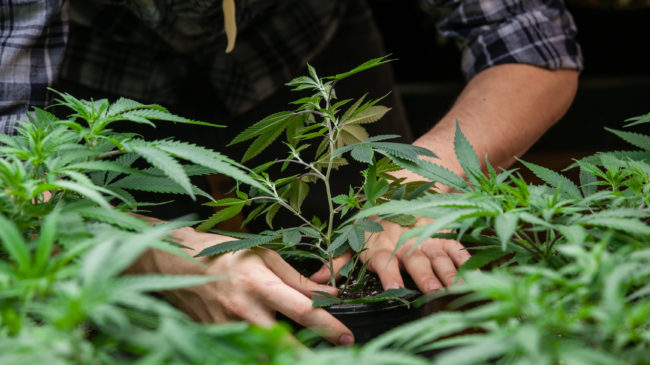Montana Amendment Cl-118 and Initiative I-190: Allow for a Legal Age for Marijuana Amendment and Marijuana Legalization and Tax Initiative
Summary
These companion measures would legalize adult recreational marijuana in Montana.
Amendment CI-118 would amend the Montana Constitution to allow the legislature or a citizen initiative to establish the legal age of purchasing, consuming, or possessing marijuana, as the legislature did with alcohol. This change to the state constitution is needed to make it constitutional to allow for the changes to the law in Initiative 1-190.
Initiative I-190 would define the legal age for marijuana in Montana as 21 years or older, generally decriminalize personal adult marijuana use and possession of up to an ounce of cannabis (eight grams in concentrated form). Adults may also cultivate up to four plants if they are indoors and secured (eight total plants per residence). It would also establish a resentencing and expungement procedure for prior cannabis-related convictions. Legally-purchased cannabis would be subject to a 20 percent excise tax, and revenue would be allocated to the administration of the program, the general fund, conservation programs, veterans programs, drug addiction treatment programs, local authorities enforcing the initiative, and healthcare workers. The Montana Department of Revenue would be charged with issuing licenses and regulations to go into effect by January 1, 2022, and local authorities would also be empowered to regulate marijuana establishments and facilities.
Fiscal Impact
The Governor’s Office of Budget and Program Planning estimates that Initiative I-190 would generate total revenue of $3,516,200 in FY 2022, $18,007,800 in FY 2023, $28,640,800 in FY 2024, and $38,523,200 in FY 2025. After expenses for administering the program, new tax revenue is earmarked for specific uses. These numbers may be overstated as even prior to the pandemic and recession, marijuana revenues in other states have fallen somewhat short of projections.
Proponents’ Arguments For
Proponents argue that marijuana prohibition hasn’t worked. It wastes police officers’ time, clogs the courts, and costs millions of dollars each year, yet does nothing to reduce use or get rid of the black market for marijuana. State taxpayers bear all those costs while the revenue from the market goes to illicit producers and sellers. Supporters say legalizing would generate millions in new tax revenue to fund urgent needs and help constructively address any problematic marijuana use.
Police in states that have legalized marijuana have more time to focus on serious crimes, not arresting adults for something that is objectively safer than alcohol. Further, many veterans need to use Veterans Affairs (VA) doctors, who are not able to prescribe medical marijuana, so legalizing adult-use would allow veterans who marijuana to treat chronic pain, post-traumatic stress disorder (PTSD), and other serious health conditions access to it.
Eleven states have legalized adult marijuana use. None have repealed the measures and public support for legalization has only gone up in those states. Legalization has also led to declining teen use and lower opioid overdose deaths while supporting 250,000 full-time American jobs. Initiative I-190 does not permit driving under the influence of marijuana, force employers to accommodate marijuana use or impairment in the workplace, or allow public consumption.
Opponents’ Arguments Against
Opponents argue that legalizing marijuana is really a move to commercialize marijuana for profit and create a new version of Big Tobacco. They say that America is moving way too fast to legalize marijuana without considering the costs and the fact that only a small number of investors benefit from a rush to legalization.
Modern marijuana is much more potent than cannabis products of the past, containing far more THC than the weed popular in the 1960s, they say. Legalization in Colorado has led to more minority kids being arrested for pot, skyrocketing marijuana-related car crashes, use by young adults, and positives marijuana tests in workplaces, opponents claim. Decriminalizing marijuana would be much better than legalizing it and would keep commercial incentives and corporate greed out of today’s high potency pot products.
Opponents further say that marijuana legalization has not raised the revenue promised in other states, and Colorado continues to struggle to fund its education system, and legal marijuana states face a combined budget deficit this year of $71 billion.
Discussion
The reason there are two measures involved here is due to existing Montana law establishing 18 as the age of majority. A separate law requires that alcoholic beverages be purchased only by those age 21 and older, and Amendment Cl-118 effectively extends this higher age requirement to cannabis. This means that if Amendment Cl-118 were not to pass, but Initiative I-190 did, it would allow Montanans over the age of 18 to legally access adult-use marijuana under the state law.
Much of the debate on these two initiatives comes down to what voters broadly think about legalizing marijuana. Adult recreational use of marijuana is currently legal in 11 states and more and more people seem to be persuaded it is a good idea. National polling by Pew Research Center shows 67 percent of American adults say marijuana should be legal (including 55 percent of Republicans and Republican leaners), and adults who oppose legalization has fallen from 52 percent in 2010 to 32 percent today. In Montana, 51 percent support marijuana legalization (including 33 percent of Republicans).
A May 2020 YouGov poll of residents of nine states that have legalized marijuana asked if they think it is a success or failure. In five of the states, two-thirds or more of voters think it is a success, and in only one state (Maine) less than a majority (47 percent) think it is a success. In every state, 20 percent or less think legalization was a failure.
But many voters are going to want to consider the key arguments by both sides.
Estimates of state revenues can be complex, and states should be conservative in estimating revenues until they have experience and data to rely upon. All states that have legalized marijuana have seen considerable state revenues. The states that most heavily regulate and tax the legal market, stunting its growth, have seen the least reduction in the black market and generated considerably less state revenue than might have been realized in a more successful legalized market.
The same is certainly true for creating legal marijuana-related jobs. Overall job growth in the industry is robust: a 2019 nationwide analysis found 211,000 jobs in the legal cannabis industry, and that workforce increased 21 percent in 2017, another 44 percent in 2018, and anticipated at least another 20 percent t growth in jobs in 2019.
Opponents of legalizing marijuana argue that it would impose societal costs like more victims of drugged driving accidents and rising use by juveniles. These matters bear more examination, but keep in mind that they are all true of black-market marijuana, are almost all true of alcohol, and none of these were reasons why marijuana was made illegal in the first place.
Overall, research on states that have legalized medical marijuana or decriminalized marijuana possession and use has found no increase in juvenile use. And a 2019 study in the Journal of the American Medical Association found that legalizing recreational marijuana use for adults was followed by an average 8 percent decrease in juvenile use in Oregon and Colorado. Nationwide, juvenile use of marijuana has been falling since 2011, the year prior to legalization in the first states to do so—Colorado and Washington.
Studies on the effect of marijuana legalization on traffic accidents are inconclusive, as it is hard to isolate the effects due to mixed use of alcohol and THC, difficult to measure THC impairment, and difficult to separate confounding effects like marijuana use reducing drunk driving.
Even while marijuana is predominantly bought and sold in the black market, without either private and competitive incentives for quality control and safety, or any regulations with the same goal, current data show that marijuana has fewer health risks than either alcohol or tobacco. Legalizing marijuana and ending black markets would likely improve its safety.
One clear lesson from states that have legalized recreational marijuana is that the rules must evolve and adapt to fit the particulars of the state market and related laws. Initiative I-190 is 57 pages in length and specifies detailed procedures regarding licenses and business operations for the legal marijuana market. The Montana Department of Revenue is responsible for issuing regulations and licenses, including specific rules in testing, safety, and security, as well as broad authority to “eliminate the illicit market for marijuana.” The initiative details many of the rules for license applicants, including disallowing prior felony convictions involving fraud, deceit, or embezzlement, or distribution of drugs to minors, and having to submit detailed plans and background information to qualify.
For the first year that adult-use licenses are issued, the initiative exclusively limits access to current medical cannabis licensees. Cultivation premises are limited by tier sizes, with no plots allowed larger than 35,000 square feet (tier 10). New licensees must start at the second-lowest tier, while current medical licensees (or those purchasing a current medical license) may choose any tier. Larger plots, including any potential increases over tier 10, are only allowed through a petition procedure under defined conditions. These and other provisions would likely increase and consolidate the adult market power of existing medical licensees.
Local governments cannot ban cannabis businesses without a vote of the people, although they can enact specific health and safety inspections or other requirements.
The initiative bans licensees from advertising “in any medium” except specific business listings. They are also banned from posting prices or “actively solicit[ing]” consumers. Since businesses have a right to communicate with consumers and differentiate their product in a truthful and non-misleading manner, this provision may well be challenged in court and stripped out.
Voters’ Guide to Other Marijuana Legalization and Drug Policy 2020 Ballot Initiatives
Voters’ Guides to 2020 Ballot Initiatives on Other Policy Topics


